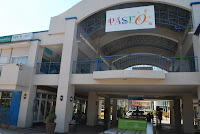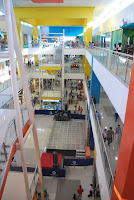The very first
that I have visited was Paseo. The structure and design of the place was pretty
much Western. It was open space where the typical Filipino malls are indoors.
As a result, the place had beautiful view. The stores were well-divided by section
and they were all located in one common section. For instance, the stores for
cloth were located in one side where the bars and restaurants were located in
the other side of the load.



Even though I arrived there on Friday, there were only few people because, according to security guard, the place is usually occupied in the evening. Since I have arrived in the place around 2 pm, I was not able to observe much of the mall culture among the customers. According to the sales clerks, on the other hand, I was able to find out that most of the customers are foreigners such as Koreans, Japanese, and Americans (or minorities/riches). Most of them were assumed to live in nearby villages. Since the main customers are foreigners, the mall seems to be developed as modern as possible to satisfy the foreigners.
 Compared
to Paseo, the mall had its very distinguish structure, indoor and lengthy. The
structure and designs of the mall was pretty much same with other SM in Metro
Manila. So, I was able to distinguish SM Calamba with other SM. Moreover, I was
also able to compare this place with Paseo where I have observed in the very
beginning.
Compared
to Paseo, the mall had its very distinguish structure, indoor and lengthy. The
structure and designs of the mall was pretty much same with other SM in Metro
Manila. So, I was able to distinguish SM Calamba with other SM. Moreover, I was
also able to compare this place with Paseo where I have observed in the very
beginning.
It is not very sure whether the social class of the customers affects on the size of the space and number of stores. But, compared to other SM, SM Calamba had smaller space and limited stores. I was able to ask one of the customers on the reason why they visit SM Calamba. They said it is cooler than the outside and has everything they want; ‘buy everything you want in one place’. The place is usually occupied by family members and the masses of the Philippines. It is more approachable for the masses compared to Paseo.

 Among
the places that I have visited, Liliw was the most impressive one, because I was,
somehow, feel the tradition Filipino market. I said ‘somehow’ because the
modern(commoditized) and the traditional culture was coexisting in the place. The
cultural product in this place is shoes. In order to commoditize this culture
for tourists(foreigners/minority) and other visitors(masses), the products have
been commoditized and the shoes became the symbol of Liliw. In addition, some
stores were located with one another in order to strengthen the products.
Among
the places that I have visited, Liliw was the most impressive one, because I was,
somehow, feel the tradition Filipino market. I said ‘somehow’ because the
modern(commoditized) and the traditional culture was coexisting in the place. The
cultural product in this place is shoes. In order to commoditize this culture
for tourists(foreigners/minority) and other visitors(masses), the products have
been commoditized and the shoes became the symbol of Liliw. In addition, some
stores were located with one another in order to strengthen the products.
The
traditional foods were well-observed in this place such as bibingka and buko
wine. I have tried some of the foods that were sold in this place in order to
experience the cultural products in this region. The whole street, as a result,
became one traditional culture for the neighbors in that place.
Night Culture
I also had a chance to
experience the night culture in Laguna near UPLB(University of the Philippines Las
Banos). The place was similar with University Mall(U-Mall) near De La Salle
University-Manila. The main differences were price of the foods and the
customers. Compared to U-Mall, the price of the foods was really cheap and
satisfied. Most foods were sold with almost 70% of the prices in Manila.
Furthermore, the place was very calm, not noisy, and had very pleasant environment.
I assume that the socially different accumulation of wealth and price of the land
estate defined the difference in these two regions.
The other cultural differences that I have observed was on performing the aerobic. The aerobic that was performed in SM Calamba seemed to be more commoditized compared to the aerobic that was performed in UPLB. In SM Calamba, the purpose of performing the aerobic is more on showing the people on their cultural practices. The purpose of aerobic that was performed in UPLB, however, has weighted more social network between the neighbors and the health issues. Even the common cultural practices were performed differently in one region. This indicates that even in small community, diverse culture is existing.


댓글 없음:
댓글 쓰기